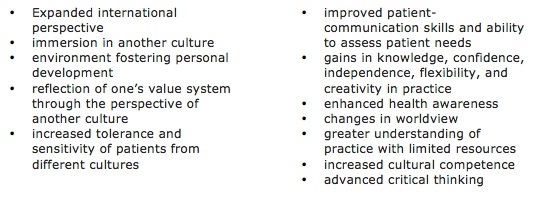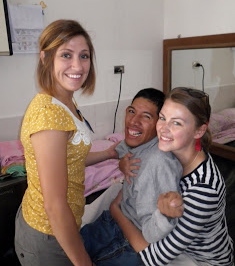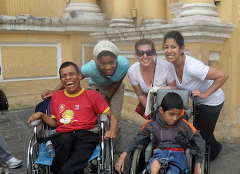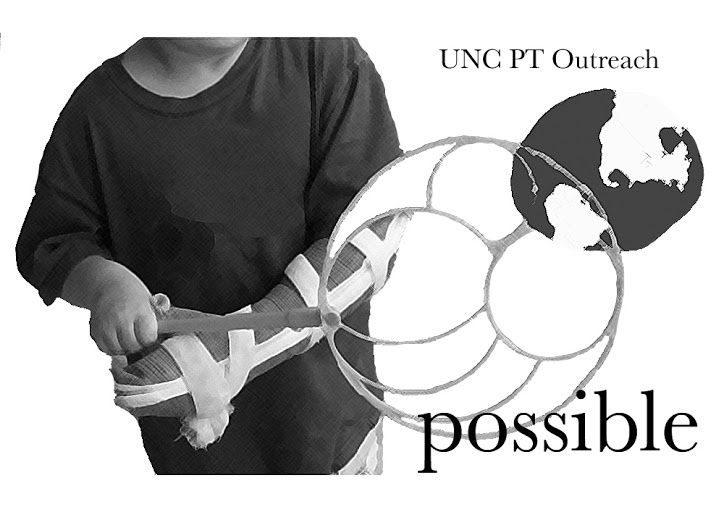Strategies for Integrating Cultural Competency Training Among Physical Therapy Professionals in the UNC DPT Program
By: Kimberly Dale and Betsy Frederick
Doctorate of Physical Therapy (DPT) programs utilize multiple strategies to incorporate cultural competency training and globalization into the curriculum. In addition to including public and global health content in didactic coursework, DPT programs utilize experimental erudition through service learning experiences and the associated educational partnerships, exchanges, and reflective practices accompanying the experience.1 For our capstone, we have chosen to focus on two avenues in which cultural competency is being integrated into UNC’s DPT program: a didactic learning and a service learning experience.
Didactic Learning:
Cultural Competency: An Ongoing Process PowerPoint
Overview: Significant racial and ethic disparities in access to care, service utilization, quality and health outcomes in the United States have prompted the need to educate health care professionals on strategies to provide culturally competent services. One way that UNC’s department of physical therapy attempts to reduce racial and ethnic disparities in health care is through the didactic curriculum of their students. During the first semester of UNC’s DPT Program, new students are required to take a psychosocial-based class. This psychosocial class explores how behavior, social structures, beliefs and interactions influence the interaction of physical therapists with patients, peers, and the community. During the Fall of 2012 semester, Christina Grey, DPT, presented a powerpoint presentation as part of her student Capstone addressing the importance of cultural competency in physical therapy. Christina’s Capstone focus was cultural competency education to first year students through a powerpoint presentation named “Breaking Down Barriers: The Road to Achieving Cultural Competency”. As part of the powerpoint portion of our Capstone, we improved upon this powerpoint to best meet the needs and curriculum of students as well as future patients. We independently and collaboratively reviewed the previous students’ feedback related to this presentation and have revised/updated it with the goal of addressing the concerns of the student audience. Betsy led editing and revamping of the original powerpoint now called “Cultural Competency: An Ongoing Process”. This newly developed powerpoint which explores cultural competency in healthcare, and more specifically physical therapy, will be presented to all first year UNC-Chapel Hill DPT students during their psychosocial class in the first semester of PT school education starting in the fall of 2013.
Students: First year DPT students
Goals: To respond to the feedback of the 2012 UNC DPT students in order to better address cultural competency through a two hour didactic learning experience during their psychosocial class.
Summary of Feedback from Christina’s Powerpoint: Students expressed through their feedback that they would like the activities in the presentation to be better integrated into the informative aspects of the powerpoint and to include a tool to evaluate their current level of cultural competency. In addition they thought that less information on the slides and more information on how to appropriately conduct an evaluation or treatment session with a person from another culture would be beneficial.
How we addressed Feedback Concerns: To address the integration of activities concern, we organized activities into places that enhanced the flow, consistency, and continuity of the powerpoint. We also added a quiz to help students explore and reflect upon their own cultural competence in order to facilitate personal and professional reflection. Information on slides regarding models of cultural competency were prioritized and condensed so that pertinent information was highlighted. These revisions allotted for more time to introduce additional information that would have direct implications on our students. For example, information from the APTA regarding the ethical, personal, and professional obligations of practicing with cultural competency addressed through documents of Core Values, Code of Ethics, and Vision 2020 were included to stress the importance and investment of cultural competency as a student and professional. The importance of cultural competency as a continuous, and ever evolving journey is well stressed along with how to develop cultural competency skills starting in the first year of physical therapy education.
Powerpoint: Our new Cultural Competency An Ongoing Process Power Point presentation, activities such as the Kalima Exercise, and reflective discussions will first be introduced to UNC’s first year physical therapy students in the Fall of 2013 semester.
At the beginning of the presentation, students have the opportunity to reflect on their cultural comptency and worldview knowledge through the “Village of 100” exercise.
Click here if you are interested in self assessing your own knowledge through the Village of 100 Exercise Questions, then see how your answers compare to reality by watching the video below.
Village of 100 Answers: [youtube]http://www.youtube.com/watch?v=twQED8zOBDo&feature=related[/youtube]
Service Learning Manuscript:
Longitudinal effects of Service-Learning Experiences on Physical Therapy Students
Overview: Increasingly over the last decade, physical therapy programs have also responded to growth in healthcare disparities by offering on-site cultural competency training to their students through service learning opportunities during their education. Though the rising trend to include service learning in physical therapy programs is evident, research regarding the growing involvement of physical therapy programs in global health initiatives and their effects on students’ cultural competency is limited.1 Kimberly has led the writing and formulation of a new manuscript under the direction of Sadye P Errickson analyzing the longitudinal effects of international service learning (ISL) participation on physical therapy students one year post-ISL. Dr. Errickson has been co-leading the UNC Physical Therapy’s week-long Guatemala Project opportunity for the past 3 years, conceptualized the study’s design, and collected the data via surveys post-ISL. We both then joined the team in the Fall of 2012 in order to complete a comprehensive literature review regarding existing evidence of service learning in health professional students’ education, assist in coding and analysis of the qualitative data, and formulate the manuscript. The manuscript has undergone multiple revisions since its first draft thanks to monthly revision meetings with Dr. Errickson as well as feedback received from committee members through an evaluation tool at the midterm of our project. The manuscript is currently in the drafting and editing process and will be submitted for publication to a peer-reviewed journal and conference presentation upon completion. Because the manuscript and associated data are not yet published, we are unable to post our draft and results at this time. However, below is a brief bulleted outline of the manuscript in development for easy reading:
Students: Self-selected third year students of the UNC Doctorate of Physical Therapy Program
Goal: To increase the knowledge, awareness, and skills on the role of cultural competency in physical therapy education and clinical practice.
What Is Service Learning and Why Is It Important?
- Service learning is “a structured learning experience that combines community service with explicit learning objectives, preparation, and reflection.”1,2,3,4
- There are currently 650 million people worldwide with disabilities, many of which do not have access to rehabilitation.1 Students and healthcare professionals are becoming increasingly involved in service learning to address this global need for services and promote cultural competence training.
- Why is it specifically important for physical therapy?
- According to the APTA, physical therapists (PTs) share the legal, ethical, social, and personal responsibility to practice physical therapy in a culturally competent manner and respond to societal needs for health and wellness.2,5,6
- Practicing in a culturally competent manner is necessary to increase the likelihood of effective outcomes and reduce racial and ethnic disparities in healthcare7; PT graduates must be prepared for diverse patient populations in their practice within the US and while meeting global healthcare needs.8
Existing evidence for Benefits of Service Learning on health care professional students:
- Immediate Effects: 9-12
- Longitudinal Effects:9, 13
Purpose:
- Evidence measuring the effects of service learning on participating PT students specifically is limited compared to other healthcare professional fields at this time.
- Further, the long-term effects post-ISL participation on PT students who participate in service learning, both community based and international, and the effect of ISL participation on them in their professional careers is not known at this time.
- This longitudinal study aims to understand the opinions that physical therapy students possess regarding the impact of participating in a service learning experience and its long standing consequences on the way they practice.
Development of Guatemala Project
- Pechak and Thompson provide a conceptual model for establishing an ISL with 5 phases3:
- Development: Establish a connection and relationship to a host community and identify needs.
- In this study, a UNC-CH ISL was initiated in 2009 by a small group of students and faculty (D. Phillips, Sayde Errickson). Guatemala was established as needing current evidence-based evaluation and treatment approaches for Guatemalan PT’s.
- Design: logistical planning and funding.
- Students and faculty collaborated to design a week-long ISL experience intended to benefit UNC-CH students, therapists, and patients of Antigua, Guatemala as well as the surrounding areas.
- UNC-CH DPT students in the spring of their third year are able to voluntarily participate as well as UNC-CH DPT faculty and program alumni.
- Participants are given an outline of financial responsibilities and each cohort organizes various fundraising efforts (letters campaigns, trivia nights, t-shirt sales) as needed. Faculty and alumni typically fund their trip through independent or fundraising efforts.
- Implementation: providing direct collaborative care to patients and education/training to staff and community partners.
- The first trip occurred in the Spring of 2010 with subsequent annual trips in the spring of 2011 and 2012.
- Sites of Partnership in Antigua, Guatemala include:
- Development: Establish a connection and relationship to a host community and identify needs.
- Obras Sociales del Santo Hermano Pedro (Las Obras) – a hospital and primary residence for over 230 children and adults with developmental disabilities.
- From Houses to Homes, San Jose Medical Clinic– a nonprofit organization which seeks to strengthen the Guatemalan community through building homes, improving access to health care, education, and community participation.
- “Enseñame a Pescar” Foundation- a school aiming to provide quality education and health services to children with disabilities.
- Evaluation and Enhancement: identification of successes and barriers are discussed and analyzed following the ISL each year in order to improve and expand the program based on reflections.
Methods:
- In this study, we assessed 2 cohorts of students (n=19, mean age= 27.05 years, 1 African American student, 18 Caucasian students) that have participated in this ISL to date.
- We aimed to understand the impact of their student ISL experience on their current clinical practice.
- The 2010 and 2011 cohort were surveyed at two and one year, respectively, post-ISL with 9 respondents. Respondents provided their level of agreement (strongly disagree, disagree, neutral, agree, strongly agree) on the following statements:
- I think an international trip is necessary to gain cultural competency
- I have a responsibility to serve the community in which I live
- I think a service learning experience should be a course requirement in the DPT program.
- The service learning experience increased my knowledge, skill, and/or attitudes related to cultural competency
- The service learning experience increased my knowledge, skill, and/or attitudes to address the needs of my current PT community.
- The service learning trip increased my awareness of my own biases and prejudices.
- It was beneficial to return to Guatemala as a young alumnus.
- Responses were entered into an excel spreadsheet and independently coded by six investigators (Betsy Frederick, Kimberly Dale, Cassie Short, Beverley Knight, Sadye Paez Errickson, and Darcy Little) to identify open codes in the qualitative data. Investigators compared codes through collaborative discussion to identify and reach consensus on major themes.
- The 2012 cohort (n=8, mean age=25 years, 3 African American students, 5 Caucasian students) is currently being surveyed at this time and this data will be joined to the existing database, analyzed, and added to the results once complete.
- Themes will then be shared with other ISL faculty for review prior to complete development of overall themes regarding the impact of ISL on student’s perspectives and future clinical practice.
Results
- Formulation of the results is currently in progress. Data analysis has been completed for the 2010 and 2011 cohorts at this time. We are anticipating data collection by May of 2013 for the 2012 cohort. The database including this cohort will then be analyzed by June of 2013.
Conclusion:
- Following analysis, the data will then be used to identify student’s perceived successes, barriers, and longitudinal impact of their trip. This information will aid in further establishment and reorganization of implementing ISL into Doctorate of Physical Therapy curriculums nationwide and at UNC. The dissemination of this information through national conference presentation and the completion of a manuscript publication in a peer reviewed journal will then be utilized to increase awareness and development of cultural competency education in physical therapy professional students.
A Moment of Reflection:
Reflection is central in order to self assess cultural competency and gain optimal learning, development, and growth from a service learning opportunity.2 We have found through this process that the role of reflection is equally as important in preparing to educate others about cultural competency, synthesis of collected data, and drafting of a manuscript. Both of us had never had experience with coding qualitative data and are continuously learning the ropes of the thought-provoking, frustrating, sometimes tedious, yet rewarding process of writing a manuscript for submission. We are so thankful for our team of Beverly Knight and Cassie Short for all of their aid in compiling/coding the data as well as our committee members, Darcy Little and Catherine Noonan, whose experience and revisions have helped guide us along the way. Of course, none of this would be possible however without the hard work of Dr. Sadye Errickson and her research. Thank you providing us with and guiding us through this amazing professional learning opportunity.
_____________________________________________________________________________________________
References:
1.Pechak CM, Thompson M. A conceptual model of optimal international service-learning and its application to global health initiatives in rehabilitation. PhysTher. 2009;89(11):1192-1204. doi: 10.2522/ptj.20080378; 10.2522/ptj.20080378
2.Lattanzi J, Black, Pechak C, M. Educating globally minded physical therapist students: Curriculum strategies to equip the next generation. J PHYS THER EDUC. 2012;26(1):55-60.
3. Abedini NC, Gruppen LD, Kolars JC, Kumagai AK. Understanding the effects of short-term international service-learning trips on medical students. Acad Med. 2012;87(6):820-828. doi: 10.1097/ACM.0b013e31825396d8;10.1097/ACM.0b013e31825396d8.
4. Seifer, S. D. Service-learning: Community-campus partnerships for health professions education. Academic Medicine, 1998: 73(3):273-7.
5. American Physical Therapy Association. APTA Guide for professional conduct. November 2010.
6. American Physical Therapy Association. Professionalism in Physical Therapy: Core Values. American Physical Therapy Association, Alexandria, VA; August 2003.
7. Like RC. Educating clinicians about cultural competence and disparities in health and health care. J Contin Educ HealthProf. 2011;31(3):196-206. doi:10.1002/chp.20127; 10.1002/chp.20127.
8. Sawyer KL, Lopopolo RL. Perceived impact on physical therapist students on an international pro bono clinical education experience in a developing country. Journal of Physical Therapy Education. 2004;18(2):40-47. 9. Zorn CR. The long-term impact on nursing students of participating in international edu- cation. Journal of Professional Nursing. 1996;12:106-110.
9. Zorn CR. The long-term impact on nursing students of participating in international education. Journal of Professional Nursing. 1996;12:106-110.
10. Bartholomew D. International communication: an investigation into the learning experiences of British and Russian student nurses. Journal of Nursing Management. 1996;4:353-357.
11. Lee NJ. Learning abroad: the benefits for nursing. Journal of Nursing Management. 1997;5:359-365.
12. Pechak C, Thompson M. Going global in physical therapist education: International service-learning in US-based programmes.Physiother Res Int. 2011;16(4):225-236. doi: 10.1002/pri.501; 10.1002/pri.501
Other References that have aided us in our research and formulation of the manuscript to this point:
American Physical Therapy Association. APTA Guide for professional conduct. November 2010.
American Physical Therapy Association. Professionalism in Physical Therapy: Core Values. American Physical Therapy Association, Alexandria, VA; August 2003.
Association of American Medical Colleges. 2012 Medical School Graduate Questionnaire: All Schools Summary Report. https://www.aamc.org/download/300448/data/2012gqallschoolssummaryreport.pdf. Accessed February 13, 2013.
Code of Ethics. Alexandria, Va: American Physical Therapy Association; 2000. Standards of Practice for Physical Therapy and the Criteria. Alexandria, Va: American Physical Therapy Association; 2000.
Ethics and Judicial Committee. Principle 10.1. In: APTA Guide for Professional Conduct. Alexandria, Va: American Physical Therapy Association; November 2002.
Haq CL, Rothenberg D, Gjerde CL, et al. New world views: preparing physicians in training for global health work. Family Medicine. 2000;32:566-572.
Lie DA, Lee-Rey E, Gomez A, Bereknyei S, Braddock C. Does cultural competency training of health professionals improve patient outcomes? A systematic review and proposed algorithm for future research. J Gen Intern Med. 2011; 26(3): 317-325.
Ramsey AH, Haq C, Gjerde CL, Rothenberg D. Career influence of an international health experience during medical school. Fam Med. 2004;36(6):412-416. Accessed 1/5/2013 3:16:36 PM.
Reynolds PJ. How service-learning experiences benefit physical therapist student’s professional development: A grounded theory study. Journal of physical therapy education. 2005;19(1):41.
Wainwright S, Shepard K, Harman L, Stephen J. Novice and experienced physical therapist clinicians: a comparison of how reflection is used to inform the clinical decision-making process. Phys Ther. 2010; 90(1): 75-88.








3 Responses to “Strategies for Integrating Cultural Competency Training Among Physical Therapy Professionals in the UNC DPT Program”
Darcy
Kim and Betsy, I think you did a wonderful job organizing your capstone. Cultural competency can be a difficult topic to address as multiple definitions exist and there is no standard measurement tool. You took on a lot and appropriately organized and presented the information.
The changes made to the powerpoint are thoughtful and appropriate. The powerpoint now engages the students in reflection, discussion, and allows them to see the importance of cultural competence in practice.
Hope the project means even more now that you’ve experienced it first hand! I thoroughly enjoyed our trip. Your class is incredible!
paulaanw
Betsy and Kimberly, Your post is very diverse and meets a need which is so often overlooked. The inclusion of an “opening” assessment tool of one’s current attitude is great for a presentation. Not only as a group “ice breaker,” but it also helps to set the mindset for your material in the presentation. What is great about working, being immersed in other cultures is that we actually may learn more about ourselves than the specifics of that culture. Either way, the project is a great way to learn about others!
Thanks for the references,
Paula Anne-Marie
jtooher
Hi Kim and Betsy!
What a big project you 2 have undertaken, but I really enjoyed reading everything that you have done and learned over the course of the year. Cultural competency and service learning are near and dear to my heart, and as you both know, I’m so disappointed that I can’t make the Guatemala trip this year.
I think the Kalima exercise and your Powerpoint presentation are great additions to the first year curriculum. The list of immediate and longitudinal effects of service learning really struck a cord with me also. I have worried in the past that my wanting to go on service trips has been somewhat selfish in nature (I get to travel and feel good about myself), but this list of benefits really makes me think that the experience in invaluable for professionals and for the people that we hopefully help.
I’m looking forward to hearing about all the fun and neat learning experiences you have down in Guatemala!
Jen